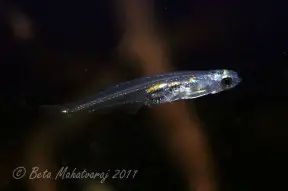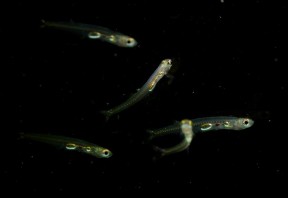Danionella priapus
Etymology
Danionella: a diminutive of the generic name Danio, in reference to the tiny adult size of 10-12 mm in this genus.
priapus: from the Ancient Greek Πρίαπος (Príapus), an ithyphallic fertility god, in reference to the conical projection of the genital papilla in males, which superficially resembles the penis of mammals.
Classification
Order: Cypriniformes Family: Cyprinidae
Distribution
Known only from the type locality, given as ‘India, West Bengal, Jalpaiguri District, Brahmaputra drainage, Jorai River, a tributary of the Sankosh at Laskarpara, outskirts of Barobisha town. 26°28′ 52.3”N, 89° 49’ 29.8”E.
Habitat
Collected from a sluggish stream with clear water, sandy substrate and dense aquatic vegetation (see image #2). Sympatric fish species included Dario dario.
Maximum Standard Length
The largest officially-recorded specimen measured 16.0 mm.
Aquarium SizeTop ↑
An aquarium with base dimensions of 45 ∗ 30 cm or equivalent should be the smallest considered.
Maintenance
Should be maintained in a planted set-up with gentle water movement, ideally with a layer of vegetation covering at least part of the surface.
Some clumps of Taxiphyllum or similar would be a useful addition as they will provide a source of micro-organisms upon which both fry and adults can feed. An air-powered sponge-type filter unit is best and should be matured before the fish are added.
Water Conditions
Temperature: 18 – 24 °C
pH: 6.0 – 8.0
Hardness: 18 – 143 ppm
Diet
Quite easily-fed despite its delicate appearance. Crushed or very fine-grade dried foods, chopped Tubifex, Artemia nauplii, microworm and sifted Daphnia are all accepted. Try to vary the diet as much as possible for the fish to remain in the best of health.
Behaviour and CompatibilityTop ↑
Given its diminutive size and the fact that breeding should be a priority for anyone interested in keeping it this species is best kept alone. If you do want to attempt a community choose other small fishes that require similar conditions such as Celestichthys, Boraras, or Microdevario spp.
It is a schooling species by nature so buy as many as you can; ideally no less than a dozen.
Sexual Dimorphism
Females are noticeably deeper-bodied than males, and when gravid eggs are often visible within the body cavity, while in males the genital opening and anus are located anterior to those of females, between the pelvic fins. Males also possess a conical projection of the genital papilla which is absent in females, and may be unique within the order Cypriniformes.
Reproduction
This species may not have been bred in aquaria although Pete Liptrot and Paul Dixon of the Bolton Museum Aquarium, UK, have achieved great success with an unidentified congener, probably D. translucida. They first noticed fry from their group of 24 adults after moving the school to a dedicated set-up planted with mature Java moss and have since rewarded with regular batches of fry.
The eggs were deposited in individual, cone-shaped masses directly onto the substrate and fry raised using a combination of Paramecium and green water until large enough to accept Artemia nauplii and microworm. A number of spinal deformities were observed in the second generation of fry.
NotesTop ↑
This species was referred to as D. sp. ‘Jorai River’ prior to its description.
It can be distinguished from other members of the genus by the following combination of characters: males with a conical projection of the genital papilla forming a funnel-like structure between the pelvic fins (vs. genital papilla not developed as a conical projection and pelvic fins not funnel-shaped); 8 pectoral-fin rays (vs. 6–7); 20–21 anal–fin rays (vs. 12–14 in D. dracula, 12–16 in D. translucida, and 17–19, rarely 20 in D. mirifica), and by having the last anal-fin pterygiophore inserted anterior to haemal spine of vertebra 27 or 28 (vs. 21 or 22 in D. translucida, 23–25 in D. mirifica, and 22–24 in D. dracula).
The small adult size in Danionella spp. evolved via a process known as miniaturisation, characterised by sexually mature adults with a significantly reduced size of less than 20mm SL. Among bony fishes cypriniformes are one of the few groups in which this phenomenon occurs repeatedly, with all Barboides, Danionella, Microdevario, Microrasbora, Horadandia, Boraras, Sawbwa and Sundadanio species representing miniaturised taxa, alongside a few members of Brachydanio, Celestichthys, Laubuca and Rasbora. All show a preference for still or slow-moving waters, often in nutrient-poor habitats such as forest peat swamps.
The anatomical structure of miniaturised cyprinids can vary greatly; there are two putative groups with some species possessing intermediate features to some degree. The first contains those fishes which though small are essentially proportionally dwarfed versions of their larger relatives.
The other includes those in which anatomical development stops at a point where adult still resemble a larval form of their larger ancestor, as in Danionella. Such fishes are usually referred to as ‘developmentally truncated’ or ‘paedomorphic’ and are thought to have evolved via a process known as ‘progenetic paedomorphosis’, i.e., paedomorphosis brought about by accelerated maturation.
They typically exhibit a simplified skeletal structure along with species-specific morphological peculiarities, such as the tooth-like projections in male Danionella dracula. Britz et al. (2009) consider that developmental truncation may have facilitated the development of such novelties ‘by freeing large parts of the skeleton from developmental constraints, dissociating developmentally linked pathways and creating a greater potential for more dramatic changes’. For example in addition to its amazing jaw structure D. dracula lacks forty-four bones (or bone parts) compared with the zebra danio, Brachydanio rerio.
The phylogenetic position of Danionella has proven tricky to establish but most modern studies have recovered it as being most closely related to Esomus spp. or as sister group to all other danionins (Fang et al. 2009).
References
- Britz, R., 2009 - Zootaxa 2227: 53-60
Danionella priapus, a new species of minature cyprinid fish from West Bengal, India (Teleostei: Cypriniformes: Cyprinidae). - Britz, R. , K. W. Conway, and L. Rüber, 2009 - Proceedings of the Royal Society of London, Series B - Biological Sciences 276: 2179-2186
Spectacular morphological novelty in a miniature cyprinid fish, Danionella dracula n. sp. - Fang, F., M. Norén, T. Y. Liao, M. Källersjö and S. O. Kullander, 2009 - Zoologica Scripta 38(1): 1-20
Molecular phylogenetic interrelationships of the south Asian cyprinid genera Danio, Devario and Microrasbora (Teleostei, Cyprinidae, Danioninae). - Roberts, T. R., 1986 - Environmental Biology of Fishes 16(4): 231-241
Danionella translucida, a new genus and species of cyprinid fish from Burma, one of the smallest living vertebrates. - Rüber, L. , M. Kottelat, H. H. Tan, P. K. L. Ng and R. Britz, 2007 - BMC Evolutionary Biology London 7: 1-10
Evolution of miniaturization and the phylogenetic position of Paedocypris, comprising the world's smallest vertebrate.




